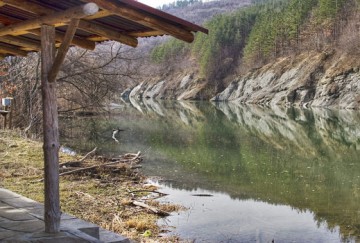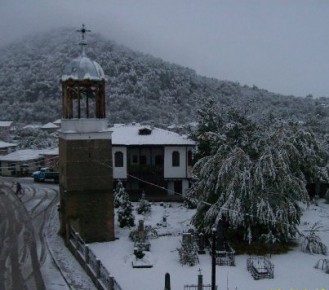Information about the town of Zlataritsa
 The municipality of Zlataritsa is located in the eastern part of Veliko Tarnovo region and borders the municipalities Elena, Veliko Tarnovo, Strajitsa and Antonovo (Targovishte).
The municipality of Zlataritsa is located in the eastern part of Veliko Tarnovo region and borders the municipalities Elena, Veliko Tarnovo, Strajitsa and Antonovo (Targovishte).Zlataritsa municipality consists of 24 settlements 1 town and 23 villages- municipal center town Zlataritsa, two villages with mayors – Novo Gorsko Selo and Rodina and 8 settlements with deputy mayors.
Totally depopulated settlements are 4 - Gorsko Pisarevo village, Durovtsi, Rekichka and Chukata. Villages with population of 1-5 people are: Delova Mahala, Ovoshtna, Chistovo, Novogortsi and Gorna Hadjiiska. The total area of the municipality is 232,676 acres.
Municipality Zlatarica falls on the first folds of the mountain. The northern part of the municipality has a flat character.
The majority of its territory is hilly topography formed by a number of low-and medium-high ridges parallel to the main Balkan Chain. They are deeply cut by transverse gorges in flowing Zlatarishka and Bebrovska River.
The lowest parts are altitude of 100 m (80 m in the valley of the Zlatarishka river after village of Rodina) and the highest 900 meters (peak "Kulata" - 901.3 meters on the border with the municipality of Elena). Prevailing terrain with an average altitude of 300 to 600 m.
Municipality Zlataritsa falls on the part of Northern Bulgaria and Predbalkanska valley sub region of moderate continental climate. The climate is temperate continental, reminiscent of this bass and northern parts of the region. Lower temperatures are in January and the highest in July. Monthly average maximum temperatures in summer are around 28 degrees C and minimum winter - minus 6 degrees C. The average annual temperature is around 11-12 degrees C. Registered extremely low absolute maximum temperatures when the north invaded arctic air masses.
The average annual rainfall is around 650-750 liters per square meter. With a maximum in June and minimum in February. Dominated by rainfall. Permanent snow cover lasts 33-46 days a year. There are rare and late spring frosts. There are 3-4 drought period lasts about 10 days. In river valleys fogs, which adversely affect the cold period.
 Prevailing west and northwest winds. They bring moist air masses from the west. In some seasons there is a strong east and northeast winds. They are quite strong and cold, but do not have this power, and blow snow. Foehn or Southerner, as people called it, blows in February, March and early spring especially on the northern slopes of Elena, a consequence of which the rivers coming strong. This wind disperses north of Zlataritsa because of entering the Danube plain.
Prevailing west and northwest winds. They bring moist air masses from the west. In some seasons there is a strong east and northeast winds. They are quite strong and cold, but do not have this power, and blow snow. Foehn or Southerner, as people called it, blows in February, March and early spring especially on the northern slopes of Elena, a consequence of which the rivers coming strong. This wind disperses north of Zlataritsa because of entering the Danube plain.The municipality is rich in surface waters. Through its territory run four rivers:
-River Zlatarishka /Barzitsa/ comes from the neighboring municipality of Elena, passing through the town Zlataritsa and then flows into the River Veselina.
Veselina River-known as Kapinska River originates from the central Stara Planina ridge. Passes through the villages of Novo Gorsko Selo, village of Rodina and town of Zlataritsa. It leaves the municipality from the village of Djulyunitsa. In the upstream was built dam "Yovkovtsi" managed by "WSS - Yovkovtsi" Ltd. Veliko Tarnovo;
Bebrovska river passes through the territory of the villages Razsoha, Dedintsi, Rosno, Gorsko Novo Selo village and flows into the river Veselina.
Stara Reka river flows in peripheral villages of Cheshma and Slivovitsa.
All the rivers have almost constant flow except for the summer when water levels are substantially reduced.
The territory of the municipality there are 10 dams that enrich more water supplies. Used primarily for breeding and fish breeding.
Oaks form pure or mixed stands. Have most often sprout. The greatest distribution of tree species are different types of oak trees. As undergrowth in the composition of plantations found hawthorn, dogwood, hazel, lilac, etc. Besides these in greater or less amount were found hornbeam, maple and lime. In the high areas forests are tall. Artificial trees are made of white and red pine, fir, maple and others.
The appearance of the landscape typical of the front of the mountain trees define the presence of wild pigs, deer, pheasants and other birds species.
The municipality revealed three mounds near the town Zlataritsa encountered in Middle Neolithic and continued existence in the early and middle Chalcolithic. They found small tools. Not localized settlements from the Bronze and Early Iron Age. There are many burial mounds, which are related to Thracian people. They represent artificial mounds of different sizes. Precise dating of all mounds could not be done because of the many missing data information, material and articles related to the funeral ritual. The study found that they are loose in three main periods: the first period - XII-XIV century BC, second period - VII century BC and third - VII-XIV century found early Bronze Age monuments that are partially explored. These are strongholds of the defense system destroyed in antiquity. No registered monuments and settlements of the First Bulgarian Empire.
Revealed was a medieval church /XIII - XIV century/ in the village of Novo Gorsko Selo, which is under investigation.
 After the liberation of Bulgaria from Ottoman rule Zlataritsa exist as an independent administrative unit. One hundred years later by Decree № 2295 of the Council of Ministers published in the Official Gazette No. 101 since 1978 Zlataritsa again established as a municipality in the region Veliko Tarnovo. Settlements in the municipality have been created even before the Liberation - during the Second Bulgarian Kingdom. Name Zlataritsa is associated with the extraction of gold from the river. This craft was utilized by miners, who have settled in this region after the suppression of the Chiprovsko rebellion. According to an official document of Sultan Selim in 1791 Zlataritsa had 440 houses. The area of the municipality there are three mounds before 6-7 thousand years. In the "Gradishteto" there are remains of fortress walls. South of the Roman road passes to Constantinople.
After the liberation of Bulgaria from Ottoman rule Zlataritsa exist as an independent administrative unit. One hundred years later by Decree № 2295 of the Council of Ministers published in the Official Gazette No. 101 since 1978 Zlataritsa again established as a municipality in the region Veliko Tarnovo. Settlements in the municipality have been created even before the Liberation - during the Second Bulgarian Kingdom. Name Zlataritsa is associated with the extraction of gold from the river. This craft was utilized by miners, who have settled in this region after the suppression of the Chiprovsko rebellion. According to an official document of Sultan Selim in 1791 Zlataritsa had 440 houses. The area of the municipality there are three mounds before 6-7 thousand years. In the "Gradishteto" there are remains of fortress walls. South of the Roman road passes to Constantinople.In the town of Zlataritsa there are two historical museums of local importance, one of which is the former modern for its time secondary school, built in 1860, the Church "St. Nicholas" which is a monument of culture. It is unique with its frescoes, icons and architectural style.
Zlataritsa is the birthplace of the famous healer Dimitar Stoyankov /buy Mityo/ by death awarded the title of "citizen of honor" of the ctown.
On May 11, 2003 on the occasion of the patronal feast of "St. St. Cyril and Methodius"in Zlataritsa ethnographic exhibition was opened in which were exposed tools, implements, costumes and other stuff related to the various ethno-cultural groups in the municipality - Bulgarians, Roma, Vlachs and Turks.
Tourist interest in the municipality are the natural resources, cultural and historical sites, ethnographic and folklore heritage of the region.
 Zlataritsa Municipality has a relatively favorable tourist geography. By road network, it is associated with an important tourist center in the country /Veliko Tarnovo/ and highway Sofia - Varna. The majority of the municipal road network is in poor condition, which impedes access to the municipality, especially in winter conditions and affects the attendance area.
Zlataritsa Municipality has a relatively favorable tourist geography. By road network, it is associated with an important tourist center in the country /Veliko Tarnovo/ and highway Sofia - Varna. The majority of the municipal road network is in poor condition, which impedes access to the municipality, especially in winter conditions and affects the attendance area.The close proximity of the region to Stara Planina mountain, the clean mountain air, the landscapes - one of which is "Lunna Dolina" in the area "Ribartsi" - Srednoselski Balkan- make it total attractive place for tourism. It is difficult to be reached, and the easiest way is walk. This beautiful area is known to a narrow circle of archaeologists as the summer residence of the kings of Turnovo. Excavations were not made. Currently being implemented project "Construction of eco trail along the Stara Reka River between municipalities Zlataritsa and Antonovo" in "PHARE - Development of Bulgarian Ecotourism", which is part of a regional product "Sredna Yantra" created with the participation of municipalities Strazhica, Antonovo /Targovishte/, Zlataritsa, Pavlikeni, Hotnitsa and Veliko Tarnovo.
Municipality Zlataritsa works on the project "Beautiful Bulgaria" and other programs. Activities include repair and restoration work on the facades and roofs of some buildings.
As a potential tourist attraction in the region can be considered railroad Gorna Oryahovica - Elena, which passes through the municipality with existing plans for its tourist exploitation.
Water bodies (rivers and small dams) in the municipality are regularly visited by tourists for sports and fishing. Presence of specific cultural resources, combined with the favorable natural conditions are preconditions for the development of ecological and sustainable tourism in the municipality. This would allow to combine vacation with hobby activities, skills and meet the need for emotional experiences and impressions.
Zlataritsa Properties

